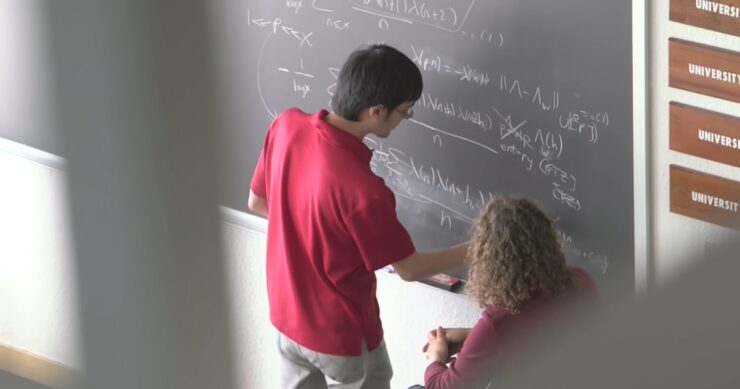Mathematics, often referred to as the language of the universe, is an integral part of human civilization. Its history is as rich and varied as the cultures that contributed to its development.
This journey, spanning from the ingenious geometric patterns of ancient Greece to the complex algorithms defining our digital age, is not just a chronicle of numbers and formulas but a remarkable narrative of human thought and its quest to understand the world.
In this blog post, we will navigate through the labyrinth of the history of math, unraveling the stories of the great minds whose work has shaped the modern world.
Ancient Greek Mathematics

The dawn of math can be traced back to ancient Greece. This era was marked by extraordinary thinkers like Pythagoras, whose theorem is still a cornerstone of geometry. Euclid, often referred to as the ‘father of geometry,’ revolutionized the field with his work ‘Elements,’ setting the foundation for systematic study.
Then there was Archimedes, who, with his concepts of volume and buoyancy, stretched the boundaries of math. These mathematicians did not just solve problems; they wove a fabric of math thought that has clothed centuries of scientific and philosophical inquiry.
Mathematics in Ancient Egypt
In the shadows of the pyramids and the Sphinx, ancient Egyptian civilization thrived, with mathematics as one of its central pillars. This was a world where mathematics was not just about numbers but about a profound understanding of the universe.
The Egyptians used math to construct architectural marvels and to solve everyday problems.
The Rhind Mathematical Papyrus stands as a testament to their math prowess, showcasing their skills in algebra, geometry, and fractions, and offering a glimpse into a civilization where mathematics was intertwined with the fabric of everyday life.
Today, we have come a long way from Greece and Egypt to what we have today with outlets such as https://myedspace.co.uk/.
Indian Mathematics
Ancient India was a cradle of profound mathematical thought and innovation. Mathematicians like Aryabhata and Brahmagupta were not just scholars; they were visionaries who introduced the world to concepts that are still fundamental to modern math.
The introduction of the decimal system and the concept of zero revolutionized mathematics, opening up new possibilities and simplifying calculations.
This was a math renaissance that reshaped the world, making calculations easier and more accessible, and laying the groundwork for future scientific and mathematical discoveries.
The Golden Age of Islam
During the Islamic Golden Age, mathematics flourished like never before. The works of Al-Khwarizmi and Al-Kindi were not just scholarly pursuits; they were bridges connecting the math heritage of ancient Greece and India with the future.
This era was marked by the translation and preservation of ancient texts, ensuring that the mathematical knowledge of the past would not be lost to time.
It was a period of intellectual prosperity, where math was not just preserved but nurtured and enhanced, paving the way for future generations to stand on the shoulders of giants.
The Renaissance and the Age of Enlightenment

The Renaissance was a period of rebirth not just for art and culture but for mathematics as well. Thinkers like Leonardo da Vinci and Galileo Galilei did not just dabble in mathematics; they revolutionized it.
This era saw a shift from the geometric approaches of the Greeks to a more algebraic and analytical perspective, setting the stage for modern math.
It was a time of transformation, where the mathematical baton was passed from the ancient to the modern, and the foundation was laid for a new era of math thought and discovery.
The Scientific Revolution
The Scientific Revolution was a seismic shift in human thought, and mathematics was at its epicenter. Sir Isaac Newton was not just a scientist; he was a mathematical pioneer whose work on calculus opened a new chapter in the history of number science.
The development of the scientific method, with its reliance on mathematics, transformed science from a philosophical pursuit into a rigorous and systematic quest for knowledge.
It was a revolution that redefined the boundaries of math and science, setting humanity on a new trajectory of discovery and understanding.
18th and 19th Century Mathematics
The 18th and 19th centuries were a period of unprecedented mathematical growth. Mathematicians like Leonhard Euler and Carl Friedrich Gauss were not just solving problems; they were exploring new mathematical landscapes.
Fields like number theory and non-Euclidean geometry emerged, challenging existing paradigms and expanding the horizons of math thought. This era was a testament to the unquenchable human thirst for knowledge, driving mathematics to new heights and laying the groundwork for future discoveries.
20th Century Mathematics
The 20th century was a period of revolutionary change in mathematics. Theories of relativity and quantum mechanics challenged our understanding of the universe, and mathematicians like Kurt Gödel and Alan Turing pushed the boundaries of mathematical logic and computation.
This was an era of profound discovery and innovation, where math not only responded to the challenges of the times but reshaped our understanding of the world. It was a century where the abstract and the practical met, driving technological advancement and deepening our understanding of the numerical universe.
The Digital Age

In the digital age, mathematics has become more crucial than ever. It’s the backbone of algorithms and computer science, driving advancements in technology and shaping the modern world. Mathematicians have not just contributed to this era; they have defined it.
Their work has transformed the digital landscape, making possible the technologies that we now take for granted. This is a testament to the power of math, not just as a tool for solving problems but as a force that shapes our reality.
Modern Mathematics and Unsolved Problems
As we step into the 21st century, mathematics continues to be a vibrant and dynamic field.
Contemporary mathematical breakthroughs and ongoing research are pushing the boundaries of what we know, and the famous unsolved problems like the Riemann Hypothesis and P vs. NP continue to challenge the brightest minds.
This is a testament to the enduring nature of math, a field that is as much about the journey as it is about the destination, constantly evolving and reshaping our understanding of the universe.
Conclusion
The history of mathematics is a testament to human creativity and intellect. From the geometric intricacies of ancient Greece to the algorithmic complexities of the digital age, mathematics has been a constant companion in our quest to understand the world.
Its enduring significance is a reminder of the universal language that binds us all, a language of numbers and shapes that transcends cultures and epochs.
As we reflect on this journey, let’s not just appreciate the beauty and power of math in our lives but also embrace the challenges and mysteries that lie ahead, continuing the eternal quest for knowledge and understanding.
#History #Mathematics #Ancient #Greece #Modern #Times





